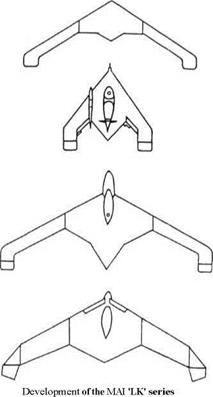MAI-62 and MAI-63
Purpose: T o investigate light flying-wing aircraft.
Design Bureau: Moscow Aviation Institute.
In 1958 the academic faculty of the Institute decided to carry out a major investigation into LK (Letayushcheye Krylo, flying wing) aircraft. The programme began with the LK-MAI glider and the MAI-59 ultralight, but these remained on the drawing board. Extensive tunnel testing of models led to a configuration with a broad diamond or lozenge-shaped centre section and swept outer panels which at their tips turned back (sweepback 90°) to terminate in surfaces doubling as airbrakes and as elevens. The MAI-62 was designed and built in 196I-62, but it was not flown until in 1965 AI Pietsukh attempted a take-off. Dur
ing the long run the engine seriously overheated and ran intermittently, and the takeoff was abandoned. The MAI-63 glider followed in 1963, first flown in 1964 by AI Pietsukh. In 1965 an engine was fitted, to produce the MAI-63M, but again the engine proved ‘unsteady’ and the aircraft never flew in this form.
Both the MAI-62 and MAI-63 were made almost entirely of wood, with birch ply veneer covering. Both had a single-seat cockpit with a sideways-hinged canopy, cable-operated wingtip elevons which could split into upper and lower halves to act as airbrakes, and fixed nosewheel landing gear. The MAI-62 was powered by a Khirt air-cooled engine of 80hp driving a two-blade pusher propeller. The years 1962-65 were spent tinkering with
the details of the wings, which had a leading – edge sweep of 45° (shown in drawings as 50°), adding or subtracting various fences, inboard flaps, trim tabs and servo tabs. Released photographs carefully avoided showing these surfaces. The MAI-63 had a much greater span, with leading-edge sweep reduced to 25°, and two different forms of split tip airbrakes supplemented by constant – chord hinged trailing edges to the main wing. The engine of the MAI-63M was a VP-760, rated at 23hp.
One is left wondering whether the failure of these aircraft to fly was really due to the engine or to doubts about their controllability.

|
|||||||||||||||||||||||||
|











